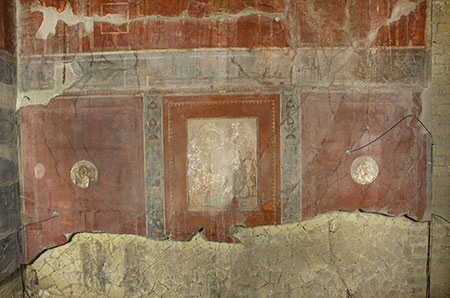Overview
This project aims to address conservation issues of decorated architectural surfaces at Herculanuem through a pilot project to study and conserve the decorated architectural surfaces in the tablinum of the House of the Bicentenary through background research, environmental monitoring and climate improvement strategies, scientific study, preventive and remedial treatment planning, testing, implementation, post-treatment monitoring, and maintenance. In addition, this project aims to inform the conservation of decorated surfaces in the Vesuvian region, which show similar problems as a result of burial by the 79 CE eruption of Vesuvius and subsequent excavation and past restorations. It is undertaken in partnership with the Archaeological Park of Herculaneum, formerly the Soprintendenza Pompei and the Herculaneum Conservation Project, as part of the Packard Humanities Institute, a philanthropic foundation that works in Italy through the Istituto Packard per i Beni Culturali.
History of the Site
When Mount Vesuvius erupted in 79 CE, the Roman seaside towns of Pompeii and Herculaneum as well as the surrounding area were engulfed by volcanic material. From that time until the 18th century, Herculaneum was buried under layers of volcanic material more than 15 meters (50 feet) deep at the base of Mount Vesuvius.
Discovered in 1709 with formal excavations beginning in 1738, Herculaneum was explored mainly by tunnels excavated in the volcanic tuff in the eighteenth and nineteenth centuries. Many richly decorated public buildings, houses and a theater yielded fine marble and bronze sculptures, wood elements, and paintings. Of particular significance, an extensive library of charred papyrus rolls was found at the Villa of the Papyri. This lavish residence served as the inspiration for the design of the Getty Villa.
Open-air excavation began in the late nineteenth century and systematic open-air excavation of the site was undertaken from 1927 until 1961 under the direction of archaeologist Amedeo Maiuri. Historical images of the site and of objects excavated over the last two centuries illustrate the alarming rate of deterioration and loss afflicting the site, much of which has occurred in recent years.
The House of the Bicentenary excavated in 1938, is considered one of the most noble and sumptuous Roman houses at the site of Herculaneum. The decoration of the tablinum, in particular, is exquisite with refined wall paintings of great artistic and archaeological significance depicting mythological scenes and figures and a unique mosaic pavement in opus sectile and opus tessellatum, to create a unified and sophisticated scheme of red, yellow, and black.
Due to the effects of the eruption of Mt. Vesuvius in 79 CE, subsequent excavation and restoration, and fluctuating environmental conditions, the wall paintings have suffered extensive deterioration, including spalling of the tuff wall, delaminated plasters, powdering and flaking of paint layers, biogrowth, and surface accumulation due to environmental pollution and coatings applied in previous interventions. The mosaic pavement has detachment and loss of tesserae.
Pilot Project
To address conservation issues of the decorated architectural surfaces in the tablinum, the GCI, in collaboration with the Herculaneum Conservation Project and the Archaeological Park of Herculaneum initiated a pilot project to study with and conserve the decorated surfaces that follows a methodological approach consisting of the following iterative steps that can be applied to wall paintings showing similar problems in the Vesuvian region.
Phases of Work
Phase I of the project, starting in 2011, with background research, condition recording, scientific study, and environmental monitoring. Based on results of the preliminary studies and condition assessment, the team developed methods and materials to stabilize the wall paintings and tested passive climate improvement strategies.
Phase II of the project includes testing and implementation of passive measures and remedial conservation treatments for the wall paintings. To date, the project team has carried out plaster and paint stabilization. Planning for cleaning, filling of cracks and losses, and visual reintegration of the wall paintings is underway.
Phase III of the project will address the conservation of the mosaic pavement. Following conservation treatment of the architectural surfaces in the tablinum, a plan for post-treatment monitoring and maintenance will be developed by the project team.
The knowledge gained from this joint program of site investigation, scientific study, and innovative conservation trials and treatment solutions will increase the understanding of deterioration present on site; and will serve as an example of a methodological approach for the conservation of similar wall paintings and decorated architectural surfaces at Herculaneum and other ancient Roman archaeological sites in the region with similar conservation issues.
Results of the project are disseminated in a variety of forms to a range of audiences in order to advance conservation knowledge and practice in the field, to inform colleagues of the methodology being followed, and the scientific study carried out.
Objectives
The pilot project will conserve the ensemble of decorated architectural surfaces in the tablinum, including conservation treatment of the wall paintings and the mosaic pavement. Environmental conditioning and sheltering of the space will ensure the long-term stability of the decorative architectural surfaces to prevent further deterioration to the exquisite and irreplaceable wall paintings and mosaic pavement.
The evaluation of conditions combined with environmental monitoring and scientific study provide a basis for developing a holistic approach to the conservation. A plan for post-treatment monitoring and maintenance will be drafted for use following completion of conservation treatment.
Combining scientific understanding and practical knowledge of the conservation issues of the wall paintings and mosaic pavement, this project will address the conservation issues of flaking and powdering paint on the most celebrated wall painting elements at Herculaneum, an archaeological site of international significance. The approach developed in the model project will be applicable to the conservation of decorated architectural surfaces at other ancient Roman sites.
Page updated: November 2017



